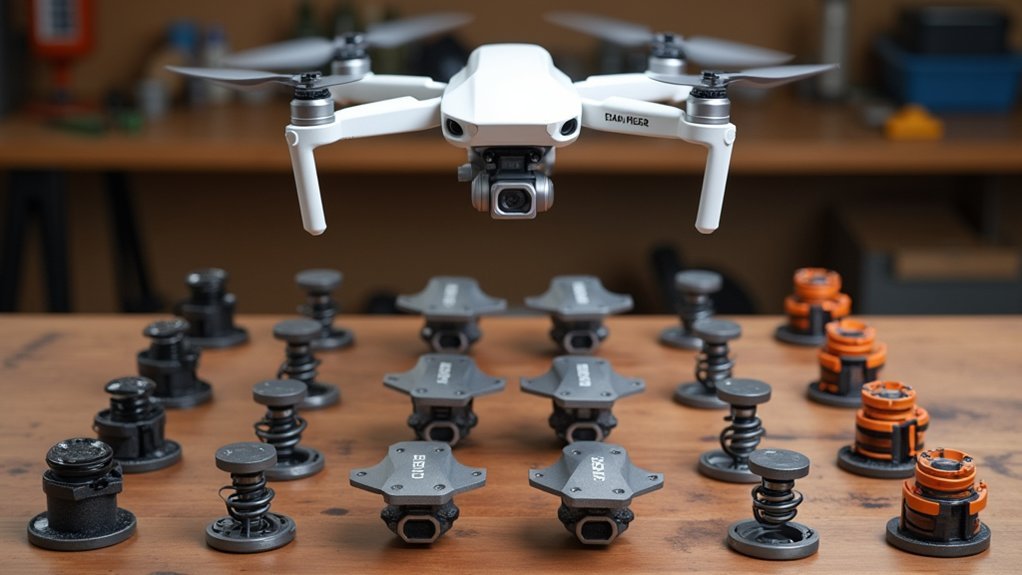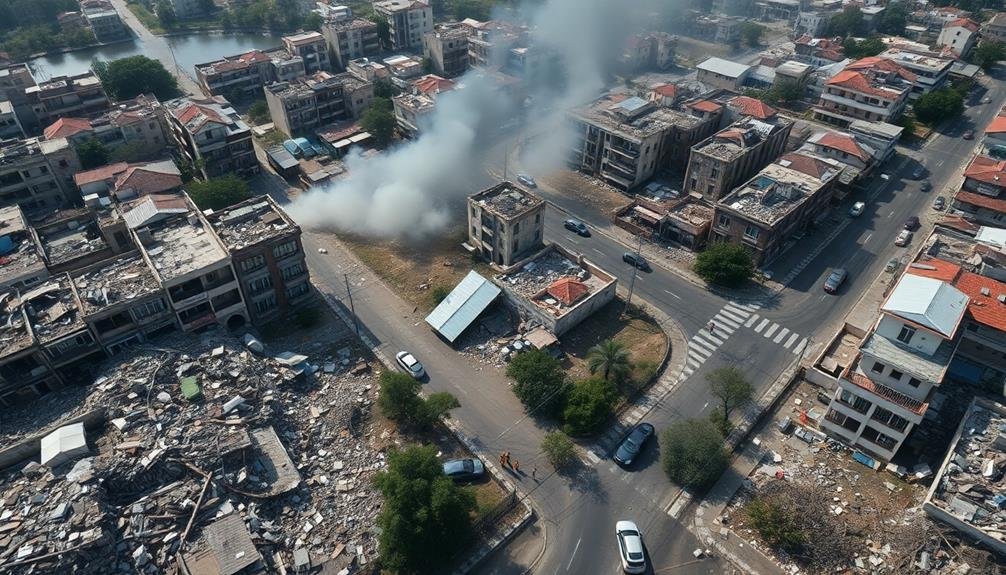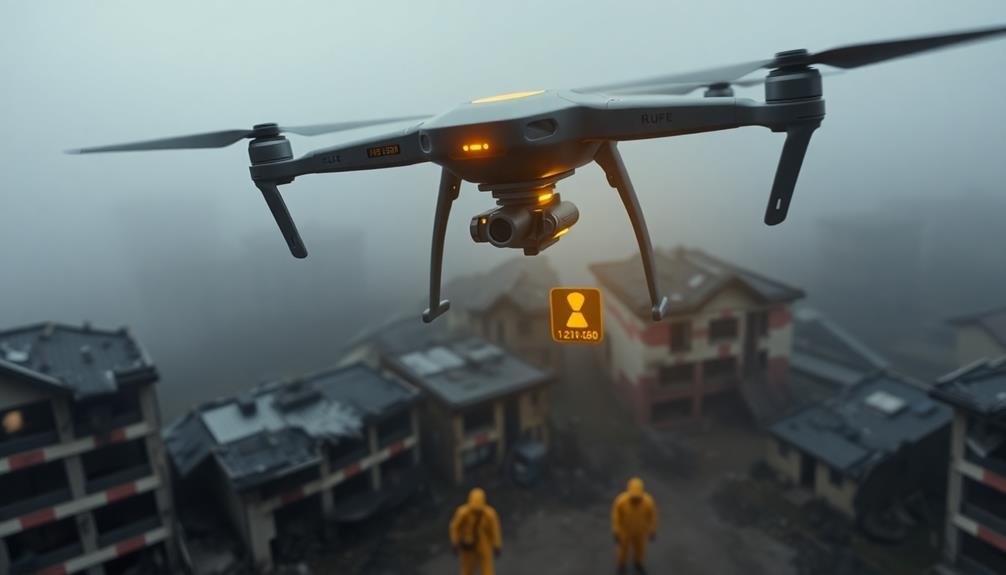Urban planning surveys are soaring to new heights with seven cutting-edge aerial strategies. You'll find drone-enabled 3D mapping techniques creating precise city models, while high-altitude data collection methods track urban sprawl. Aerial infrared imaging reveals thermal patterns for energy efficiency, and LiDAR integration provides unparalleled precision in surveys. Multi-spectral analysis offers insights on vegetation health and land use, while real-time urban monitoring solutions enable immediate responses to city issues. Finally, vertical photogrammetry applications facilitate detailed facade mapping. These sky-high approaches are transforming how you can understand and plan urban environments. Explore further to access the full potential of these game-changing strategies.
Drone-Enabled 3D Mapping Techniques

Soaring above cityscapes, drones equipped with advanced sensors are revolutionizing urban planning through 3D mapping techniques. You'll find these aerial marvels capturing intricate details of buildings, streets, and infrastructure with unprecedented accuracy.
They're equipped with LiDAR sensors, high-resolution cameras, and GPS technology to create precise 3D models of urban environments. You can use these drone-generated maps to analyze building heights, identify potential development sites, and assess infrastructure conditions.
They'll help you detect changes in urban landscapes over time, enabling more informed decision-making for city planners and developers. You'll appreciate the efficiency of drones in surveying large areas quickly, reducing the time and cost associated with traditional mapping methods.
When you integrate drone-captured data with GIS software, you'll reveal powerful analytical capabilities. You can simulate urban growth scenarios, study traffic patterns, and plan for sustainable development.
These 3D maps also prove invaluable in disaster preparedness, allowing you to identify flood-prone areas or assess building stability in earthquake-prone regions. By harnessing drone technology, you're elevating urban planning to new heights, quite literally.
High-Altitude Data Collection Methods

Satellites and high-altitude aircraft offer a bird's-eye view that's transforming urban planning. You'll find these methods provide expansive coverage and detailed imagery, allowing you to analyze large urban areas efficiently. They're particularly useful for tracking changes over time, monitoring urban sprawl, and identifying potential development sites.
High-resolution satellite imagery lets you capture data on building heights, land use patterns, and infrastructure networks. You can use multispectral sensors to assess vegetation health, water quality, and heat island effects. Aerial photography from planes or balloons provides even more detailed images, helping you spot fine-grained urban features.
These high-altitude methods offer several advantages:
- Unparalleled coverage of vast urban regions
- Ability to bypass ground-level obstacles
- Reduced need for time-consuming on-site surveys
- Regular, consistent data collection for long-term monitoring
- Integration with GIS systems for powerful spatial analysis
You'll find that combining high-altitude data with ground-based observations creates a thorough understanding of urban environments. This integrated approach enables you to make more informed decisions about zoning, transportation planning, and sustainable development strategies, ultimately shaping more livable and resilient cities.
Aerial Infrared Imaging for Planning

Aerial infrared imaging takes urban planning to the next level by revealing hidden thermal patterns across cities. You'll find this technology invaluable for identifying heat islands, energy inefficiencies, and infrastructure issues. By capturing thermal radiation emitted from surfaces, you can map temperature variations throughout urban areas.
You'll use specialized cameras mounted on aircraft or drones to collect infrared data. These images highlight areas of heat loss in buildings, helping you pinpoint where energy efficiency improvements are needed. You can also detect underground utility issues, such as leaking pipes or faulty electrical systems, before they become visible problems.
In your planning efforts, you'll leverage this data to design greener cities. You'll identify areas that need more vegetation to combat urban heat islands and improve air quality.
You can also use infrared imaging to assess the effectiveness of green roofs and cool pavement initiatives.
LiDAR Integration in Drone Surveys

You'll find LiDAR integration in drone surveys revolutionizes urban planning with its unparalleled precision in 3D mapping.
This technology allows you to capture intricate details of cityscapes, including building heights, terrain features, and vegetation density.
Additionally, you can collect real-time data during flights, enabling rapid assessment and decision-making for urban development projects.
Precision in 3D Mapping
One of the most significant advancements in urban planning technology is the integration of LiDAR (Light Detection and Ranging) sensors with drone surveys. This combination allows for unprecedented precision in 3D mapping, revolutionizing the way you plan and develop urban spaces.
LiDAR-equipped drones can capture millions of data points per second, creating highly detailed digital representations of cityscapes.
You'll find that this technology offers unparalleled accuracy, even in complex urban environments. It's capable of penetrating vegetation and capturing subtle terrain variations that traditional methods might miss. This level of detail is essential for making informed decisions about infrastructure development, zoning, and resource allocation.
The emotional impact of this technology can't be overstated:
- Awe at the intricate 3D models of entire cities
- Excitement about the potential for more efficient urban planning
- Relief knowing that development decisions are based on precise data
- Pride in using cutting-edge technology to improve urban life
- Hope for creating more sustainable and livable cities
Real-time Data Collection
Real-time data collection takes LiDAR-equipped drone surveys to the next level.
You'll find that integrating LiDAR technology with drones allows for immediate, highly accurate data gathering during urban planning surveys. As you fly the drone, LiDAR sensors continuously emit laser pulses, measuring the time it takes for each pulse to bounce back. This process creates a detailed 3D point cloud of the surveyed area in real-time.
You can instantly view and analyze the collected data on your ground control station, making on-the-spot decisions about areas that need further investigation. This capability considerably reduces the time and resources required for follow-up surveys.
You'll also appreciate the ability to adjust flight paths mid-survey based on the incoming data, ensuring thorough coverage of complex urban environments.
Real-time data collection enhances your ability to detect and respond to potential issues quickly. You can identify structural anomalies, assess vegetation encroachment, or evaluate infrastructure conditions as the drone flies.
This immediate feedback loop allows for more efficient urban planning processes, enabling you to make informed decisions faster and with greater confidence.
Multi-Spectral Analysis From Above

Multi-spectral analysis from above has revolutionized urban planning by providing a wealth of information about city landscapes. You'll find this technology invaluable for evaluating various aspects of urban environments, from vegetation health to building heat signatures. By capturing data across multiple wavelengths of light, you're able to detect details invisible to the naked eye.
Using specialized cameras mounted on satellites or drones, you can gather essential information about land use, infrastructure conditions, and environmental factors. This data helps you make informed decisions about urban development, sustainability initiatives, and resource allocation.
You'll be amazed by the insights multi-spectral analysis offers:
- Identify areas of urban heat islands
- Detect water pollution in rivers and lakes
- Evaluate the health of urban green spaces
- Monitor urban sprawl and land-use changes
- Assess the energy efficiency of buildings
Real-Time Urban Monitoring Solutions

Building on the foundation of multi-spectral analysis, real-time urban monitoring solutions offer an even more dynamic approach to city management.
You'll find these systems integrating various data sources to provide up-to-the-minute insights on urban conditions. They combine satellite imagery, ground sensors, and IoT devices to create an extensive picture of city life.
With these solutions, you can track traffic patterns, air quality, noise levels, and energy consumption in real-time. This allows for immediate responses to emerging issues, such as rerouting traffic during congestion or adjusting energy distribution during peak times.
You'll also be able to monitor infrastructure health, detecting potential problems before they become critical.
These systems often employ AI and machine learning algorithms to analyze vast amounts of data quickly. You can use predictive modeling to anticipate future urban challenges and plan accordingly.
Real-time monitoring also enhances public safety by enabling faster emergency response times and improved crowd management during large events.
Vertical Photogrammetry Applications

When you're exploring vertical photogrammetry in urban planning, you'll find 3D building facade mapping to be an essential application. This technique allows you to create detailed, accurate models of building exteriors, capturing intricate architectural features and surface conditions.
You can also use vertical photogrammetry for vertical infrastructure assessment, examining structures like cell towers, bridges, and tall buildings for maintenance needs and structural integrity.
3D Building Facade Mapping
Vertical photogrammetry has revolutionized the way we map and analyze building facades in urban environments. You'll find that this technique allows for incredibly detailed 3D mapping of structures, capturing every nook and cranny with precision.
By using drones or specialized cameras mounted on vehicles, you can collect high-resolution images from various angles, which are then processed to create accurate 3D models.
These models prove invaluable for urban planners, architects, and conservationists. You'll be able to assess building conditions, plan renovations, and even simulate how new developments might impact the existing cityscape.
The data gathered through facade mapping can also aid in creating virtual reality experiences, allowing you to explore urban environments from your desk.
- Witness the intricate details of historic architecture come to life
- Marvel at the hidden patterns and textures across city blocks
- Feel the pulse of urban evolution as you compare facades over time
- Experience a bird's-eye view of your city's vertical landscape
- Imagine the potential for preserving and enhancing urban beauty
Vertical Infrastructure Assessment
Skyscrapers and towering structures dominate our urban skylines, but evaluating their condition can be an intimidating task. That's where vertical infrastructure assessment comes in, utilizing photogrammetry to capture and analyze these towering edifices.
You'll find that drones equipped with high-resolution cameras are game-changers in this field. They can quickly and safely capture detailed images of building facades, rooftops, and hard-to-reach areas.
These images are then processed using specialized software to create accurate 3D models of the structures. With these models, you're able to identify structural issues, assess maintenance needs, and plan renovations more efficiently.
You can detect cracks, corrosion, or other signs of wear that might be invisible from the ground. This technology also allows you to measure dimensions precisely, which is vital for retrofitting or expansion projects.
Moreover, you can use vertical photogrammetry to monitor construction progress, ensuring that work aligns with design specifications. It's also invaluable for creating as-built documentation, which is essential for future maintenance and renovations.
Frequently Asked Questions
How Do Weather Conditions Affect Aerial Urban Planning Surveys?
Weather conditions considerably impact your aerial urban planning surveys. You'll face challenges with visibility in fog or rain, wind affecting drone stability, and extreme temperatures limiting flight time. Sunlight glare can also interfere with image quality.
What Are the Legal Requirements for Conducting Drone Surveys in Urban Areas?
You'll need to obtain FAA certification, follow local regulations, and secure permissions for restricted airspace. You must respect privacy laws, maintain visual line-of-sight, and adhere to altitude restrictions. Don't forget insurance coverage for your operations.
How Accurate Are Sky-High Urban Planning Surveys Compared to Ground-Based Methods?
You'll find sky-high surveys can be highly accurate, often matching or surpassing ground-based methods. They offer wider coverage and better access to hard-to-reach areas. However, accuracy can vary depending on equipment and conditions used.
Can Aerial Surveys Detect Underground Infrastructure for Urban Planning Purposes?
You can't directly detect underground infrastructure with aerial surveys. However, you'll find they're useful for spotting surface indicators like manhole covers, valve boxes, and utility markers that hint at what's below ground.
What Training Is Required for Urban Planners to Interpret Sky-High Survey Data?
You'll need specialized training in remote sensing, GIS, and data analysis. It's essential to learn how to interpret aerial imagery, LiDAR data, and thermal maps. You should also understand urban planning principles to contextualize the information.
In Summary
You've now explored cutting-edge aerial strategies for urban planning surveys. By embracing these sky-high techniques, you'll revolutionize your approach to data collection and analysis. From 3D mapping to real-time monitoring, these methods offer unparalleled insights into urban landscapes. Don't hesitate to integrate drones, LiDAR, and multi-spectral imaging into your planning toolkit. As you soar to new heights, you'll reveal a wealth of information that'll transform your urban planning projects.

As educators and advocates for responsible drone use, we’re committed to sharing our knowledge and expertise with aspiring aerial photographers.




Leave a Reply